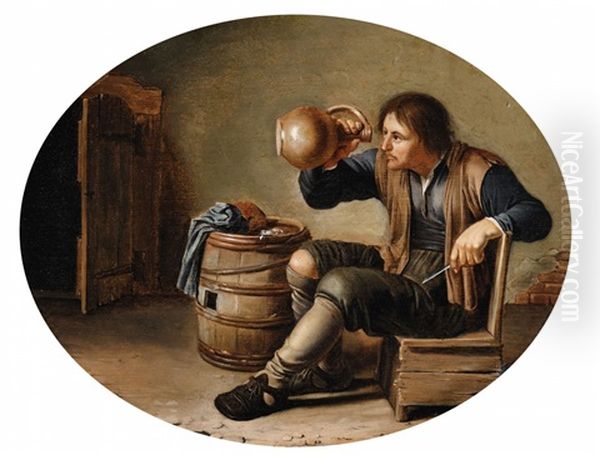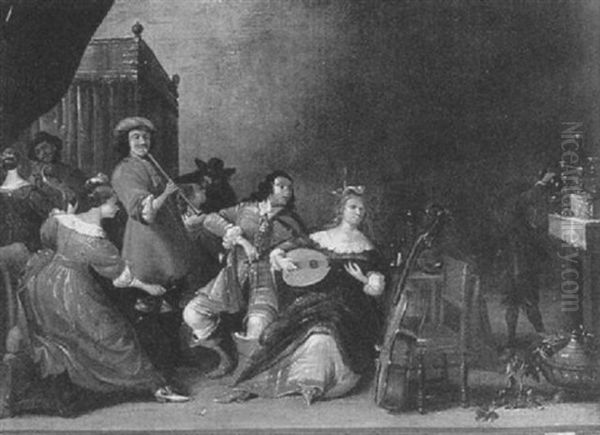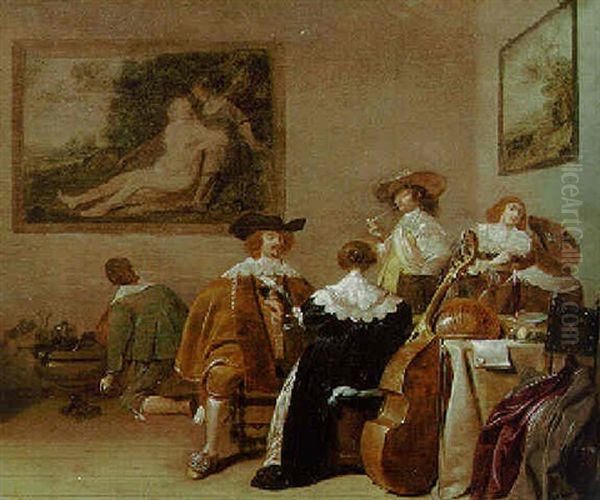Jan Olis stands as a fascinating figure within the rich tapestry of Dutch Golden Age painting. Active during the 17th century, a period of extraordinary artistic output in the Netherlands, Olis carved out a niche for himself with his engaging genre scenes, insightful portraits, and distinctive still lifes. Though perhaps not as universally renowned as contemporaries like Rembrandt or Vermeer, his work offers valuable insights into the art and life of his time. Born in Gorinchem (also known as Gorkum) in South Holland around 1610, and passing away in Heusden in 1676, Olis's career spanned several decades and locations, reflecting the dynamic artistic environment of the era.
Early Life and Artistic Formation
Born Jan Olis in the town of Gorinchem, his origins are sometimes reflected in the suffix "Gorichem" occasionally appended to his name, distinguishing him or perhaps indicating his pride in his hometown. Details about his specific training remain scarce, as is common for many artists of this period who were not part of the absolute top tier documented by chroniclers like Arnold Houbraken. However, it is certain that he emerged as a painter during a time when the Dutch Republic was experiencing unprecedented economic prosperity and cultural flourishing. Artistic production boomed, with painters specializing in various genres to cater to the tastes of a growing middle-class market. Olis likely underwent apprenticeship, the standard form of artistic education, learning the fundamentals of drawing, paint preparation, and composition under a recognized master, though the identity of this master is not definitively known.
Career Path and Travels
Olis's professional life saw him active in several Dutch cities. Records indicate his presence in Dordrecht, a major center for art and trade, and potentially The Hague or Rotterdam. This movement between cities was not unusual for artists seeking patronage, guild membership, or different artistic influences. A significant event in his development was a journey to Italy, undertaken sometime before 1651. Rome, the artistic capital of Europe, drew countless Northern European artists seeking to study classical antiquity and the works of Italian Renaissance and Baroque masters.

While in Rome, Olis is known to have participated in the activities of the "Bentvueghels" (Dutch for "Birds of a Feather"), a society of mostly Dutch and Flemish artists living in the city. This group was notorious for its bohemian lifestyle and initiation rituals, often documented under the umbrella term "Fêtes de la Bande." Membership in this group provided camaraderie and networking opportunities, placing Olis within a vibrant community of expatriate artists absorbing the lessons of Italy while maintaining their Northern European artistic identities. This experience likely broadened his artistic horizons, although his core style remained rooted in Dutch traditions.
Genre Painting: Merry Companies and Guardroom Scenes
Jan Olis is particularly noted for his contributions to genre painting, specifically depictions of "merry companies" and guardroom interiors (kortegaardjes). These scenes often feature soldiers, peasants, or middle-class figures engaged in leisure activities – drinking, smoking, playing cards, or making music. His approach captured the everyday life and social interactions of the period with a keen eye for detail and atmosphere.
Works like The Last Drop exemplify this aspect of his oeuvre. Depicting soldiers smoking and drinking, the painting focuses on a figure examining an empty wine glass, perhaps injecting a note of subtle humour or commentary on transience amidst the revelry. The composition, often intimate in scale, draws the viewer into the scene. Similarly, An Interior with Two Men Playing Cards, dated by different sources to either 1652 or circa 1670, presents a quiet moment of concentration and companionship, rendered with attention to the textures of clothing and the play of light within the room.
His "merry company" scenes often involved music. A Musical Party (1633), now housed in the National Gallery Picture Library, is an excellent example. It portrays a group gathered around music-making, with a central female figure, possibly playing a lute or similar instrument, highlighted by lighting and a vibrant pink dress. Other figures remain partially in shadow, creating a dynamic interplay of light and dark (chiaroscuro) that enhances the mood and focuses attention. These works reflect the popularity of music in Dutch society and provided artists with opportunities to depict varied textures, expressions, and social dynamics.
Skill in Portraiture
While genre scenes form a significant part of his output, Jan Olis was also a capable portrait painter. Portraiture was in high demand during the Dutch Golden Age, commissioned by wealthy merchants, civic leaders, scholars, and families seeking to record their likenesses for posterity. Although fewer portraits by Olis are known compared to his genre works, they demonstrate his ability to capture not just the physical appearance but also the perceived character and status of his sitters.

One documented example, mentioned in sources though its current location may be uncertain, is a portrait of Dr. Johan van Beverwijck, a prominent physician and writer from Dordrecht. Executing such commissions required considerable skill in rendering faces, expressions, and the textures of clothing and accessories, all of which were important indicators of the sitter's social standing. Olis's work in this field places him alongside numerous contemporaries who specialized in or frequently practiced portraiture, such as Frans Hals or Bartholomeus van der Helst, although Olis's production was likely smaller in scale.
Distinctive Still Life Paintings
Jan Olis also made contributions to the genre of still life painting, although this appears to have been a less frequent area of focus compared to his figure-based work. His still lifes are notable for their quality and sometimes unusual formats. The Dutch Golden Age saw an explosion in still life painting, with artists specializing in lavish banquet pieces (pronkstilleven), modest breakfast scenes (ontbijtjes), flower bouquets, and symbolic vanitas compositions.
Olis's Still-life with Crab and Smoker's Requirements is particularly noteworthy. Painted on a circular panel, known as a tondo, this format was relatively rare for still lifes in the 17th-century Netherlands. The composition features carefully arranged objects associated with leisure and consumption – a crab, a pipe, tobacco, perhaps a glass or jug. Olis rendered these items with meticulous attention to detail and texture, showcasing his technical skill. The choice of a tondo format suggests an interest in compositional experimentation. His approach to still life, often characterized by relatively simple arrangements compared to the opulent displays of artists like Willem Kalf or Abraham van Beyeren, nonetheless demonstrates a mastery of realism and light.
Landscape Elements
While primarily known for interiors and figure studies, Olis also incorporated landscape elements into his work and occasionally painted pure landscapes. Snippets mention works depicting peasants and livestock, aligning with a popular subgenre of Dutch landscape painting that focused on rural life. Artists like Paulus Potter specialized in animal painting within landscapes, while others like Adriaen van de Velde often populated idealized landscapes with figures and animals. Olis's engagement with landscape, even if secondary to his other interests, underscores the versatility expected of many artists during this period and the pervasive interest in the Dutch countryside as a subject.
Artistic Style and Technique

Jan Olis's style is firmly rooted in the Dutch Realist tradition of the 17th century. His paintings are characterized by careful observation, detailed rendering, and a sophisticated understanding of light and shadow. He typically worked with oil paints, often on wood panels for smaller works and canvas for larger compositions. His brushwork could be fine and meticulous, particularly in rendering textures like fabric, metal, and glass, but also capable of broader handling where appropriate.
A key feature of his style is his effective use of chiaroscuro. Influenced perhaps by the dramatic lighting associated with Rembrandt van Rijn and his circle, or the Utrecht Caravaggisti earlier in the century, Olis used contrasts of light and shadow to create mood, model form, and direct the viewer's eye. This is evident in works like A Musical Party, where the main figure is illuminated against a darker background.
His compositions are generally well-balanced and thoughtfully constructed, whether the intimate focus of a two-figure scene or the slightly more complex arrangement of a merry company. While perhaps not reaching the compositional ingenuity of a Johannes Vermeer or the psychological depth of Rembrandt, Olis consistently produced works of high quality and visual appeal. His color palettes are typical of the period, often featuring rich earth tones, blacks, whites, and strategic accents of brighter color, as seen in the pink dress in A Musical Party.
Context and Contemporaries
Jan Olis worked during the peak of the Dutch Golden Age, an era populated by an extraordinary number of talented painters. The art market was competitive, yet there was also a sense of shared exploration and influence among artists. Olis would have been aware of, and likely interacted with, numerous other painters. His guardroom scenes place him in dialogue with specialists in this genre like Jacob Duck, Pieter Codde, Willem Duyster, and Anthonie Palamedesz. His merry company scenes echo themes explored by artists ranging from the elegant gatherings of Gerard ter Borch to the boisterous peasant scenes of Jan Steen or Adriaen van Ostade.

His time in Dordrecht connects him to a local school that included artists like Aelbert Cuyp and Nicolaes Maes (a Rembrandt pupil). His still life work can be compared to that of specialists like Pieter Claesz. or Willem Claeszoon Heda, though Olis's output was less focused. The mention of potential influence from Pieter de Hooch, known for his tranquil domestic interiors and mastery of light and perspective, suggests Olis was engaged with the leading artistic developments of his time. His trip to Rome also placed him in contact with artists like the Bamboccianti (painters of low-life scenes) and other Northern Europeans absorbing Italian lessons. The overall artistic environment was one of intense activity, specialization, and mutual awareness, if not always direct collaboration or documented rivalry.
Notable Works and A Curious Case
Several works stand out as representative of Jan Olis's skill and thematic interests:
A Musical Party (1633): An early work showcasing his talent for group composition and light effects in a merry company setting.
The Last Drop: A characteristic guardroom or tavern scene, capturing soldiers at leisure with a touch of narrative or commentary.
An Interior with Two Men Playing Cards (dated variously 1652 or c. 1670): A fine example of his intimate genre scenes, focusing on quiet concentration.
Still-life with Crab and Smoker's Requirements: Demonstrates his skill in still life and his use of the less common tondo format.
A Gallant Scene / Scene of a Feast (1652): Likely another example of his merry company or elegant gathering paintings.
An interesting anecdote surrounds A Musical Party. During a cleaning in 1969-70, a figure of a boy retrieving a bottle from a wine cooler, located in the lower-left background, was removed. At the time, it was considered a later addition of inferior quality. However, examination of pre-cleaning photographs has led some art historians to believe the figure might have been original to Olis's work, possibly even a hidden self-portrait. This incident highlights the complexities of conservation and interpretation, and adds a layer of intrigue to Olis's work, suggesting potential hidden meanings or personal references within his seemingly straightforward genre scenes.
Legacy and Art Historical Position
Jan Olis Gorichem occupies a position as a skilled and versatile painter within the Dutch Golden Age, often categorized among the "minor masters" – a term that reflects the incredibly high number of competent artists active during the period rather than a lack of talent. While he did not achieve the fame of the era's giants, his work is consistently well-executed and provides valuable examples of popular genres like merry companies, guardroom scenes, and still life.
His relative obscurity in historical accounts means that his work has perhaps been historically undervalued. However, ongoing research and the art market continue to bring painters like Olis to greater attention. He contributed to the diversity of Dutch art through his specific thematic choices (like the tondo still life or his particular take on soldier scenes) and his skillful synthesis of prevailing stylistic trends. His paintings are held in various museums and private collections, appreciated for their charm, technical proficiency, and depiction of 17th-century Dutch life. He represents the solid bedrock of talent upon which the towering reputations of the most famous Golden Age masters were built.
Conclusion
Jan Olis was a talented Dutch painter whose career spanned the dynamic middle decades of the 17th century. From his origins in Gorinchem to his work in major Dutch cities and his formative trip to Rome, he developed a distinct artistic voice. Specializing in genre scenes of merry companies and guardrooms, while also proficient in portraiture, still life, and landscape elements, Olis created works characterized by detailed realism, skillful handling of light, and engaging subject matter. Though not always in the historical spotlight, Jan Olis remains an important figure for understanding the breadth and depth of artistic practice during the Dutch Golden Age, his paintings offering a window onto the social customs and visual culture of his time.